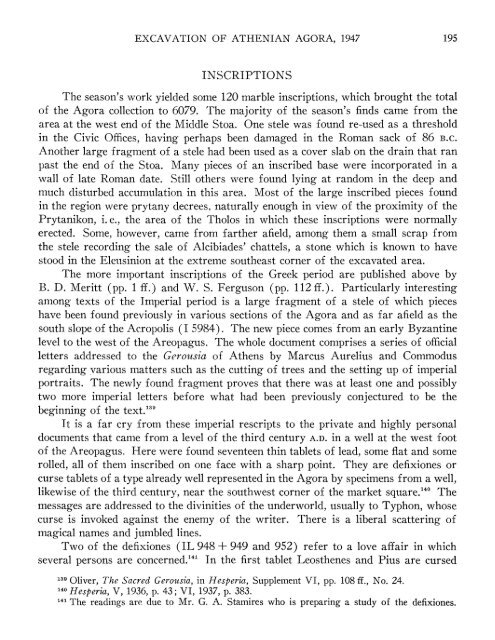the excavation of the athenian agora twelfth season: 1947
the excavation of the athenian agora twelfth season: 1947
the excavation of the athenian agora twelfth season: 1947
Create successful ePaper yourself
Turn your PDF publications into a flip-book with our unique Google optimized e-Paper software.
EXCAVATION OF ATHENIAN AGORA, <strong>1947</strong> 195<br />
INSCRIPTIONS<br />
The <strong>season</strong>'s work yielded some 120 marble inscriptions, which brought <strong>the</strong> total<br />
<strong>of</strong> <strong>the</strong> Agora collection to 6079. The majority <strong>of</strong> <strong>the</strong> <strong>season</strong>'s finds came from <strong>the</strong><br />
area at <strong>the</strong> west end <strong>of</strong> <strong>the</strong> Middle Stoa. One stele was found re-used as a threshold<br />
in <strong>the</strong> Civic Offices, having perhaps been damaged in <strong>the</strong> Roman sack <strong>of</strong> 86 B.C.<br />
Ano<strong>the</strong>r large fragment <strong>of</strong> a stele had been used as a cover slab on <strong>the</strong> drain that ran<br />
past <strong>the</strong> end <strong>of</strong> <strong>the</strong> Stoa. Many pieces <strong>of</strong> an inscribed base were incorporated in a<br />
wall <strong>of</strong> late Roman date. Still o<strong>the</strong>rs were found lying at random in <strong>the</strong> deep and<br />
much disturbed accumulation in this area. Most <strong>of</strong> <strong>the</strong> large inscribed pieces found<br />
in <strong>the</strong> region were prytany decrees, naturally enough in view <strong>of</strong> <strong>the</strong> proximity <strong>of</strong> <strong>the</strong><br />
Prytanikon, i.e., <strong>the</strong> area <strong>of</strong> <strong>the</strong> Tholos in which <strong>the</strong>se inscriptions were normally<br />
erected. Some, however, came from far<strong>the</strong>r afield, among <strong>the</strong>m a small scrap from<br />
<strong>the</strong> stele recording <strong>the</strong> sale <strong>of</strong> Alcibiades' chattels, a stone which is known to have<br />
stood in <strong>the</strong> Eleusinion at <strong>the</strong> extreme sou<strong>the</strong>ast corner <strong>of</strong> <strong>the</strong> excavated area.<br />
The more important inscriptions <strong>of</strong> <strong>the</strong> Greek period are published above by<br />
B. D. Meritt (pp. 1 ff.) and W. S. Ferguson (pp. 112 ff.). Particularly interesting<br />
among texts <strong>of</strong> <strong>the</strong> Imperial period is a large fragment <strong>of</strong> a stele <strong>of</strong> which pieces<br />
have been found previously in various sections <strong>of</strong> <strong>the</strong> Agora and as far afield as <strong>the</strong><br />
south slope <strong>of</strong> <strong>the</strong> Acropolis (I 5984). The new piece comes from an early Byzantine<br />
level to <strong>the</strong> west <strong>of</strong> <strong>the</strong> Areopagus. The whole document comprises a series <strong>of</strong> <strong>of</strong>ficial<br />
letters addressed to <strong>the</strong> Gerousia <strong>of</strong> A<strong>the</strong>ns by Marcus Aurelius and Commodus<br />
regarding various matters such as <strong>the</strong> cutting <strong>of</strong> trees and <strong>the</strong> setting up <strong>of</strong> imperial<br />
portraits. The newly found fragment proves that <strong>the</strong>re was at least one and possibly<br />
two more imperial letters before what had been previously conjectured to be <strong>the</strong><br />
beginning <strong>of</strong> <strong>the</strong> text.'39<br />
It is a far cry from <strong>the</strong>se imperial rescripts to <strong>the</strong> private and highly personal<br />
documents that came from a level <strong>of</strong> <strong>the</strong> third century A.D. in a well at <strong>the</strong> west foot<br />
<strong>of</strong> <strong>the</strong> Areopagus. Here were found seventeen thin tablets <strong>of</strong> lead, some flat and some<br />
rolled, all <strong>of</strong> <strong>the</strong>m inscribed on one face with a sharp point. They are defixiones or<br />
curse tablets <strong>of</strong> a type already well represented in <strong>the</strong> Agora by specimens from a well,<br />
likewise <strong>of</strong> <strong>the</strong> third century, near <strong>the</strong> southwest corner <strong>of</strong> <strong>the</strong> market square.'40 The<br />
messages are addressed to <strong>the</strong> divinities <strong>of</strong> <strong>the</strong> underworld, usually to Typhon, whose<br />
curse is invoked against <strong>the</strong> enemy <strong>of</strong> <strong>the</strong> writer. There is a liberal scattering <strong>of</strong><br />
magical names and jumbled lines.<br />
Two <strong>of</strong> <strong>the</strong> defixiones (IL 948 + 949 and 952) refer to a love affair in which<br />
several persons are concerned."4' In <strong>the</strong> first tablet Leos<strong>the</strong>nes and Pius are cursed<br />
131 Oliver, The Sacred Gerousia, in Hesperia, Supplement VI, pp. 108 ff., No. 24.<br />
140 Hesperia, V, 1936, p. 43; VI, 1937, p. 383.<br />
141 The readings are due to Mr. G. A. Stamires who is preparing a study <strong>of</strong> <strong>the</strong> defixiones.

















